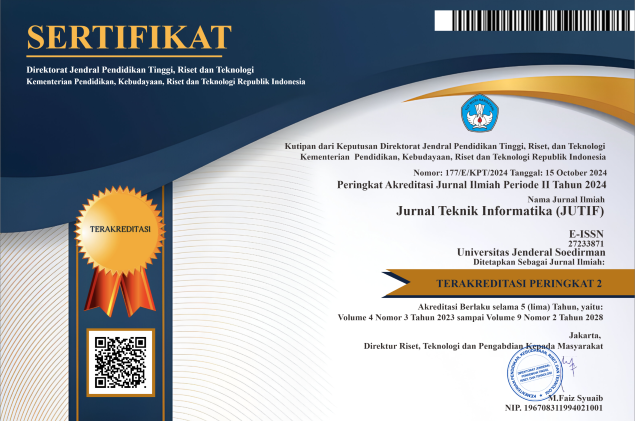SENTIMENT ANALYSIS OF POST-COVID ONLINE EDUCATION AMONG GEN Z WITH VARIOUS CLASSIFICATION METHODS
DOI:
https://doi.org/10.52436/1.jutif.2025.6.1.4003Keywords:
Naïve Bayes, Online Education, Random Forest, Sentiment Analisis, SVMAbstract
The COVID-19 pandemic has significantly changed the education sector, shifting from traditional learning to online learning. Generation Z's perception of online education is influenced by their experience as “Digital Natives” who have been familiar with technology since childhood. However, this sudden transition brings new challenges, such as screen fatigue, lack of social interaction, and difficulty in maintaining learning motivation. Sentiment analysis is an important tool to evaluate their experiences and views on online learning. This study aims to investigate Generation Z's views on online education after the pandemic, utilizing various classification methods. Data was collected from Twitter through scraping technique with specific keywords, resulting in a total of 4,986 data obtained using the Tweet Harvest library in Python programming language. The dataset then went through a preprocessing stage, including data cleaning, case folding, tokenizing, stopword removal, and stemming. Before applying Random Forest, SVM, and Naïve Bayes methods, the data is divided into two parts, namely, 3988 training data and 998 testing data with a ratio of 80:20. The accuracy results show that Naïve Bayes achieved 95.49% on training data and 76.05% on testing data, SVM recorded 94.77% accuracy on training data and 87.33% on testing data, and Random Forest obtained 99.97% accuracy on training data and 92.21% on testing data. This research provides important insights into Generation Z's perceptions of post-COVID-19 online education and learning platforms to improve the effectiveness of online learning and identify student challenges in the digital era.
Downloads
References
K. Amboro, “Kontekstualisasi Pandemi Covid-19 dalam Pembelajaran Sejarah,” Yupa Hist. Stud. J., vol. 3, no. 2, pp. 90–106, 2020, doi: 10.30872/yupa.v3i2.203.
A. F. Rochim, K. Widyaningrum, and D. Eridani, “Performance Comparison of Support Vector Machine Kernel Functions in Classifying COVID-19 Sentiment,” 2021 4th Int. Semin. Res. Inf. Technol. Intell. Syst. ISRITI 2021, pp. 224–228, 2021, doi: 10.1109/ISRITI54043.2021.9702845.
A. A. Munandar, F. Farikhin, and C. E. Widodo, “Sentimen Analisis Aplikasi Belajar Online Menggunakan Klasifikasi SVM,” JOINTECS (Journal Inf. Technol. Comput. Sci., vol. 8, no. 2, p. 77, 2023, doi: 10.31328/jointecs.v8i2.4747.
P. Elisa and A. Rahman Isnain, “Comparison of Random Forest, Support Vector Machine and Naïve Bayes Algorithms To Analyze Sentiment Towards Mental Health Stigma,” J. Tek. Inform., vol. 5, no. 1, pp. 321–329, 2024, [Online]. Available: https://doi.org/10.52436/1.jutif.2024.5.1.1817
R. Andriyanty, “Rasionalitas dan Altruisme Generasi Z,” Mediastima, vol. 30, no. 1, pp. 1–12, 2024, doi: https://doi.org/10.55122/mediastima.v30i1.1207.
S. Lestari and S. Berliani, “Analisis Sentimen Masyarakat Terhadap Isu Pecat Sri Mulyani Pada Twitter Menggunakan Metode Naive Bayes Dan Support Vector Machine,” vol. 5, no. 3, pp. 951–960, 2024, doi: https://doi.org/10.55338/saintek.v5i3.2746.
I. Moch Bima Prakoso, Imam Cholissodin, “Analisis Sentimen Masyarakat Terhadap Sistem Pembelajaran Online Selama Pandemi Covid-19 Berdasarkan Dari Twitter Menggunakan Metode Naïve Bayes,” J. Pengemb. Teknol. Inf. dan Ilmu Komput., vol. 5, no. 12, pp. 5376–5383, 2021.
H. Sujadi, “Analisis Sentimen Pengguna Media Sosial Twitter Terhadap Wabah Covid-19 Dengan Metode Naive Bayes Classifier Dan Support Vector Machine,” INFOTECH J., vol. 8, no. 1, pp. 22–27, 2022, doi: 10.31949/infotech.v8i1.1883.
L. K. Sihombing, T. Tugiono, and U. F. Sari, “Implementasi Data Mining Dalam Menganalisa Pola Penjualan Roti Menggunakan Algoritma Fp-Growth,” J. Sist. Inf. Triguna Dharma (JURSI TGD), vol. 1, no. 3, p. 228, 2022, doi: 10.53513/jursi.v1i3.5288.
Ketut Mediana Ayu Candrayani, I Made Agus Dwi Suarjaya, and Anak Agung Ketut Agung Cahyawan Wiranatha, “Analisis Sentimen Pembelajaran Daring Era Pandemi Covid-19 Menggunakan Naive Bayes dan SVM,” Tematik, vol. 10, no. 1, pp. 47–53, 2023, doi: 10.38204/tematik.v10i1.1274.
H. Setiawan, E. Utami, and S. Sudarmawan, “analisis sentimen twitter kuliah online pasca covid-19 menggunakan algoritma support vector machine dan naive bayes,” J. Komtika (Komputasi dan Inform., vol. 5, no. 1, pp. 43–51, 2021, doi: 10.31603/komtika.v5i1.5189.
R. R. S. Putri Kumala Sari, “Komparasi Algoritma Support Vector Machine dan Random Forest Untuk Analisis Sentimen Metaverse,” J. Mnemon., vol. 7, no. 1, pp. 31–39, 2024.
A. Ulfah, “Analisis Sentimen Hate Speech Pada Portal Berita Online Menggunakan Support Vector Machine (SVM),” JATISI (Jurnal Tek. Inform. dan Sist. Informasi), vol. 7, pp. 1–10, Apr. 2020, doi: 10.35957/jatisi.v7i1.196.
W. Ningsih, B. Alfianda, R. Rahmaddeni, and D. Wulandari, “Perbandingan Algoritma SVM dan Naïve Bayes dalam Analisis Sentimen Twitter pada Penggunaan Mobil Listrik di Indonesia,” MALCOM Indones. J. Mach. Learn. Comput. Sci., vol. 4, no. 2, pp. 556–562, 2024, doi: 10.57152/malcom.v4i2.1253.
H. Apriyani and K. Kurniati, “Perbandingan Metode Naïve Bayes Dan Support Vector Machine Dalam Klasifikasi Penyakit Diabetes Melitus,” J. Inf. Technol. Ampera, vol. 1, no. 3, pp. 133–143, 2020, doi: 10.51519/journalita.volume1.isssue3.year2020.page133-143.
R. Wijanarko, D. E. Ratnawati, and P. P. Adikara, “analisis sentimen dampak perkembangan artificial intelligence (ai) pada media sosial x/twitter menggunakan metode random forest,” vol. 1, no. 1, pp. 2548–964, 2017, [Online]. Available: http://j-ptiik.ub.ac.id
H. Herlawati, R. T. Handayanto, P. D. Atika, F. N. Khasanah, A. Y. P. Yusuf, and D. Y. Septia, “Analisis Sentimen Pada Situs Google Review dengan Naïve Bayes dan Support Vector Machine,” J. Komtika (Komputasi dan Inform., vol. 5, no. 2, pp. 153–163, 2021, doi: 10.31603/komtika.v5i2.6280.
D. U. Suhendra, J. Jondri, and I. Indwiarti, “Sentiment Analysis of Hate Speech on Twitter Public Figures with AdaBoost and XGBoost Methods,” J. Media Inform. Budidarma, vol. 6, no. 3, p. 1484, 2022, doi: 10.30865/mib.v6i3.4394.
R. Julianto, E. D. Bintari, and I. Indrianti, “Analisis Sentimen Layanan Provider Telepon Seluler pada Twitter Menggunakan Metode Naïve Bayesian Classification,” J. Big Data Anal. Artif. Intell., vol. 3, no. 1, pp. 23–30, 2018.
M. H. Wicaksono, M. D. Purbolaksono, and S. Al Faraby, “Perbandingan Algoritma Machine Learning untuk Analisis Sentimen Berbasis Aspek pada Review Female Daily,” eProceedings Eng., vol. 10, no. 3, pp. 3591–3600, 2023.
S. Rabbani, D. Safitri, N. Rahmadhani, A. A. F. Sani, and M. K. Anam, “Perbandingan Evaluasi Kernel SVM untuk Klasifikasi Sentimen dalam Analisis Kenaikan Harga BBM,” MALCOM Indones. J. Mach. Learn. Comput. Sci., vol. 3, no. 2, pp. 153–160, 2023, doi: 10.57152/malcom.v3i2.897.
F. A. Larasati, D. E. Ratnawati, and B. T. Hanggara, “Analisis Sentimen Ulasan Aplikasi Dana dengan Metode Random Forest,” … Teknol. Inf. dan …, vol. 6, no. 9, pp. 4305–4313, 2022, [Online]. Available: http://j-ptiik.ub.ac.id
D. Ahmad Dzulhijjah, H. Sanjaya, A. Said Wahyudi Hidayat, A. Yulistia Alwanda, and E. Utami, “Perbandingan Metode Random Forest dan KNN pada Analisis Sentimen Twitter Review BCA Mobile,” Smart Comp Jurnalnya Orang Pint. Komput., vol. 12, no. 3, pp. 767–772, 2023, doi: 10.30591/smartcomp.v12i3.5106.
V. Sari, F. Firdausi, and Y. Azhar, “Perbandingan Prediksi Kualitas Kopi Arabika dengan Menggunakan Algoritma SGD, Random Forest dan Naive Bayes,” Edumatic J. Pendidik. Inform., vol. 4, no. 2, pp. 1–9, 2020, doi: 10.29408/edumatic.v4i2.2202.
K. S. Putri, I. R. Setiawan, and A. Pambudi, “Analisis Sentimen Terhadap Brand Skincare Lokal Menggunakan Naïve Bayes Classifier,” Technol. J. Ilm., vol. 14, no. 3, p. 227, 2023, doi: 10.31602/tji.v14i3.11259.
G. A. Mursianto, D. Widiyanto, and B. T. Wahyono, “Analisis Sentimen Ulasan Pengguna Pada Aplikasi Google Classroom Menggunakan Metode SVM Dan Seleksi Fitur PSO,” Inform. J. Ilmu Komput., vol. 18, no. 3, p. 221, 2022, doi: 10.52958/iftk.v18i3.4685.
A. S. Rahayu, A. Fauzi, and R. Rahmat, “Komparasi Algoritma Naïve Bayes Dan Support Vector Machine (SVM) Pada Analisis Sentimen Spotify,” J. Sist. Komput. dan Inform., vol. 4, no. 2, p. 349, 2022, doi: 10.30865/json.v4i2.5398.
M. I. Fikri, T. S. Sabrila, Y. Azhar, and U. M. Malang, “Comparison of the Naïve Bayes Method and Support Vector Machine on Twitter Sentiment Analysis,” SMATIKA J. STIKI Inform. J., vol. 10, no. 2, pp. 71–76, 2020.


























